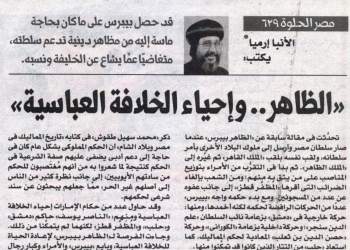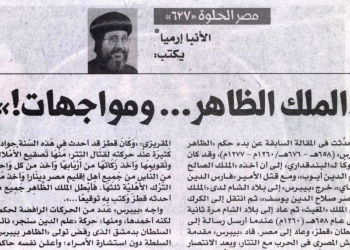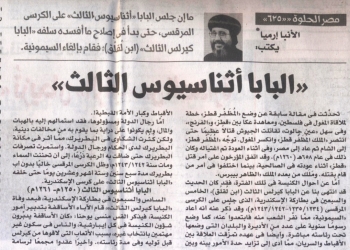قد مهدنا بسلسلة مقالات قدمناها، وهى: الإمبراطور هرقل، وشعب مقهور، وأنبا صموئيل المعترف، وتقسيم إدارى، وكساد تِجارى، وهل يحكمنا فى المدة من الثلاثين من نوفمبر 2014م إلى الحادى عشَر من يناير 2015م.
تحدثنا فى تلك المقالات عن أحوال مِصر فى أثناء حكم الروم، والصراع بين الروم والفرس الذى أدى إلى إضعاف كل منهما فى مواجهة الآخر. أيضاً كانت قسوة الروم وشدتهم وظلمهم قد وصلت إلى أشدها فى معاملة المِصريين، وقد كان الحال هكذا فى منطقة الشام بأسرها.
وذكرنا أيضًا الحرب بين الفرس والروم، وكيفية تعرض عدد كبير من المَسيحيِّين المِصريين للقتل والأسر، وتخريب ما يقرب من ستمائة دَير. وأوضحنا ما نال المِصريِّين من ألوان الذل والهوان، والأساليب المريعة لما كان يفعله المُوكل عليهم لجمع الضرائب من الشعب، والاضطهاد العقيدى الذى ظهر واضحًا فى قسوته نحو قِبط مِصر، وتقسيم مِصر إداريًا لتفتيت وَحدتها.
وتحدثنا عن التجارة فى شبه الجزيرة العربية والعَلاقات التِّجارية بينها وبين مِصر، التى عمِل بها عمرو بن العاص على تعرُّف مداخل مِصر ومخارجها وطرقها وأبنيتها وجنودها الروم وأسلحتهم، فقد تعددت الروايات إلا أنها جميعها تؤكد أن عمرو بن العاص قد دخل أرض مِصر فى أثناء حكم الروم، وعرف طرقها، وهكذا أدرك طبيعة أرضها، والجنود الروم، وأسلحتهم، وعرف حُصونها، وكنائسها، ومبانيها.
وفى ظل معاناة المِصريِّين من ويلات اضطهادات الروم الملكانيِّين الذين قتلوا وشرَّدوا، وطاردوا آلافًا، حتى إن الأب البطريرك القبطى البابا بنيامين الثامن والثلاثين من بطاركة الإسكندرية كان بعيدًا عن كرسيّه- هاربًا آنذاك من وجوههم بصعيد مصر- ليحمى الإيمان، تاركًا كرسى الإسكندرية مدة تقارب ثلاث عشرة سنة، منها عشر سنوات كان يحكم فيها الروم إلى ما بعد فتح مِصر على يد عمرو بن العاص. وأقتبس هنا كلمات د. ويليام سليمان: «إن كنيسة مِصر لم تنسَ الحِقبة الأولى من تاريخها قط، عندما لقِى الأقباط كل تعنت واضطهاد على أيدى المَسيحيِّين الملكانيِّين الذين ساموهم- باسم المسيحيةـ أشد أنواع العذاب… تاريخ أسود من قرن الخَرُّوب…».
وفى الوقت نفسه، بدأت الدعوة فى شبه الجزيرة العربية التى شرحنا جغرافيتها وأقسامها من خلال تقسيمين أساسيِّين: الأول التقسيم اليونانى والرومانى، والثانى لمؤرخين آخرين. ثم عرضنا لبعض سمات أهل هذه البلاد من معرفة القراءة والكتابة والشعر والعبادات التى انتشرت فيها آنذاك فى مقالة بعُنوان شبه الجزيرة العربية.
ومع بَدء ظهور الإسلام، حدثت الهجرة الأولى إلى الحبشة، ثم الهجرة الثانية إليها بعد تعرض المسلمين للعنف والاضطهاد. وقد كان حاكمها يسمى النجاشى، وقد وصفه الرسول بأنه لا يُظلم عنده أحد. وكانت الهجرة الأولى فى رجب من السنة الخامسة، وعاد المهاجرون فى شوال من العام نفسه، وقد ذُكر أن عددهم أربعة عشَر من الرجال والنساء الذين هربوا من مكة. وتذكر المراجع التاريخية أن المسلمين لاقوا معاملة طيبة من الأحباش، ولكنهم لم يمكثوا فيها أكثر من ثلاثة أشهر عادوا بعدها إلى بلادهم. ومع ازدياد الاضطهاد كانت الهجرة الثانية، وكان عدد المهاجرين إليها تلك المرة ثلاثة وثمانين شخصًا.
وقد عاش المسلمون فى الحبشة فى هُدوء وخير، وعمِلوا بالزراعة والتجارة. وكان لهم السلوك الطيب فأكرمهم الأحباش وعاملوهم معاملة كريمة. وقد أعلن النجاشى ملك البلاد حمايتهم، فاستطاعوا ممارسة شعائر دينهم. أمّا قريش فلم تتركهم فى أمن وسلام، إذ علِم أهلها بما وجدوه من تَرحاب، فأسرعوا فى إرسال عمرو بن العاص وعبدالله بن ربيعة إلى النجاشى حاملَين معهما هدايا كثيرة إليه، وطلبوا إليه أن يسلمهما الفارين منهم، إلا أنه رفض ذلك، وحمى الإسلام فى مهده.
رسائل إلى الملوك
وكان بعد انعقاد صلح الحُدَيبِية بين الرسول وقريش أن الرسول أرسل برسائله إلى الملوك من حوله يخبرهم بالإسلام عن طريق مبعوثين، فقد أرسل حاطب بن أبى بلتعة إلى المقوقس حاكم الإسكندرية، وشجاع بن وهب الأسدى إلى كِسرى ملك الفرس، ودحية بن خايفة إلى القيصر «هرقل» إمبراطور الروم، و«عمرو بن العاص» إلى «ابنى الجلندى» أميرَى «عمان».
وقد كانت الرسالة إلى مِصر موجَّهة إلى «المقوقس» عظيم القِبط فى مِصر – كما يسمونه – بصفته حاكمًا مدنيًا دينيًا رومانيًا. وعندما وصل «حاطب بن أبى بلتعة» إلى «الإسكندرية»، التقى «المقوقس»، وقرأ له الرسالة التى نقدم لكم صورة لها:
ويذكر المؤرخون أن هناك حوارًا دار بين «المقوقس» و«حاطب»:
– المقوقس: ألا تخبرنى عن أمور أسألك عنها، فإنى أعلم أن صاحبك تخيّرك حين بعثك.
ـ حاطب: لا تسألنى عن شىء إلا صدَقْتُك.
ـ المقوقس: إلامَ يدعو «مُحمد»؟
ـ حاطب: إلى أن تعبد الله، ولا تُشرك به شيئًا وتخلع ما سواه، ويأمر بالصلاة.
ـ المقوقس: فكم تُصلُّون؟
ـ حاطب: خَمْس صلوات فى اليوم والليلة، وصيام شهر «رمضان»، وحَج البيت، والوفاء بالعهد، وينهى عن أكل المَيتة والدم.
ـ المقوقس: من أتباعه؟
ـ حاطب: الفتيان من قومه وغيرهم.
ـ المقوقس: فهل يقاتل قومه؟
ـ حاطب: نعم.
ـ المقوقس: فصِفه لى.
فوصفه «حاطب». وأرسل المقوقس هدايا وكانت تشتمل على: «ماريا» وأختها، وابن خالتهما، وبغلة شَهباء، وحِمار أشهب، وثياب من قَُباطِى «مِصر»، وعسل من عسل «بنها»، ومال صدقة.
فتح «العراق» و«الشام» و«مِصر»
بعد وفاة الرسول، تولى الخلافة أبوبكر الصديق، ثم عمر بن الخطاب. ويذكر المؤرخون أن «حاطب» لم يكُن وحده هو السفير بين المسلمين والمقوقس، فقد أرسل الرسول شرحبيل ابن حسنة الكندى، أمّا كعب بن عدى التنوخى، فقد أُرسل مرتين فى أيام الخليفة أبى بكر الصديق، والخليفة عمر بن الخطاب.
بدأت الفتوحات العربية قبل فتح «مِصر»، فى العراق ثم «الشام»، حيث وقعت معارك كبيرة، مثل: «اليرموك»، و«القادسية»، و«نهاوند». وفى فتح «الشام»، كان المسلمون يوجهون رؤوس حرابهم نحو «دمشق» العاصمة، وكان الروم يقابلون ذلك بإرسال قوات إلى الجنوب من مواقع المسلمين حتى يتراجعوا إلى الجنوب لاستعادة الأرض التى فقدوها. إلا أن هذا الأسلوب فى الحرب لم يستطِع الروم أن يمارسوه فى مِصر بسبب اختلاف طبيعة الأراضى المِصرية المنبسطة عن أرض «الشام». وثَمة سبب آخر: أن الحروب فى الشام أضعفت قوة الروم من إمكانات حربية وجيوش، إضافة إلى المشكلات الداخلية للروم فى مِصر.
وبالعودة إلى عدد كبير من المصادر التاريخية المتنوعة، وجدنا أن خُطوات فتح مصر كانت كالآتى:
استأذن «عمرو بن العاص» الخليفة عمر بن الخطاب فى فتح مِصر ما بين العامين الثامن عشَر والتاسع عشَر الهجريَّين. ثم دخل عمرو بن العاص بجيشه إلى العريش فى نوفمبر من عام 640 م. ثم ساروا من «العريش» إلى «الفَرَما»، التى كانت تُعد أحد الحصون القوية فى أيام الفراعنة من جهة الشرق، فى يناير من عام 641 م. وما إن بلغ «المقوقس» دخول العرب إلى «مِصر»، حتى أرسل جيشًا، وتلاقى الجيشان عند «الفَرَما». وقد حاصر «عمرو» «الفَرَما» شهرًا، وحدث قتال شديد بين الجيشين، وانتصر «عمرو». إلا أن بتلر استوقفه موقف «المقوقس» فى أنه لم يُرسل جيوشًا كثيرة لمواجهة عمرو بن العاص وجيشه، ويرى أن هذه هى بداية خيانة «المقوقس» لدولة الروم بإعانة عمرو بن العاص على دخول «مِصر». وهنا نذكر كلمات «المقوقس» إلى عمرو بن العاص الواردة فى كتاب فُتوح مِصر: «لا تنقض بالقِبط، وأدخِلنى معهم، وألزِمنى ما لزِمهم، وقد اجتمعت كلمتى وكلمتهم على ما عاهدتك عليه… وأمّا الثانية إن سألك الروم بعد اليوم أن تُصالحهم، فلا تُصالحهم حتى تجعلهم فَيئا وعبيدًا، فإنهم أهل ذلك». وكان عمرو بن العاص يعلم أن «المقوقس» ضد القِبط، ويسعى لتأمين نفسه، وذلك من خلال زياراته لمِصر قبل الفتح.
ثم تقدم عمرو بن العاص، فى فبراير، من «الفَرَما» إلى «بلبيس»، مارًا بـ«القواصر» ولم يجد مقاومة تُذكر هناك. حتى وصل إلى «بلبيس»، وقاتل فيها قرابة شهر حتى استطاع فتحها، فطلب المَدد من الخليفة «عمر بن الخطاب» الذى أرسل أربعة آلاف جندى، وتمكن من فتحها فى مارس.
اتجه «عمرو» بعد ذٰلك صَوب «بابليون»، وفى الطريق وصله المَدد الأول. ثم اتجه إلى «عين شمس»، حيث دارت معركة كبيرة هربت على أثرها قوات الروم تجاه سفنهم. ثم وصل «عمرو» إلى «أم دنين»، فحدث قتال شديد ضد الروم، وانتصر عليهم، واستكمل المسير إلى حصن بابليون الذى يُعد أكبر الحصون وأقواها. ويذكر الأسقف يوحنا النِّيقُوسِى: فلما تمت عشر سنين من مُلك «هرقل»، و«المقوقس» وهو يطلب بنيامين، أنفذ ملك المسلمين سرية مع «عمرو بن العاص»… فنزل عسكرُ الإسلام إلى مِصر بقوة عظيمة فى الـثانى عشَر من بؤونة… وملك بعض البلاد… وكانت أمته محبة للبرّية فأخذوا الجبل حتى وصل إلى «قصر بابليون»، وقد حاصر الحصن مدة طويلة، قيل ستة أشهر، وفى رواية أخرى سبعة. وطلب عمرو بن العاص إمدادًا آخر من الخليفة، فأرسل إليه أربعة آلاف، وقال له: «أعلم أن معك اثنَى عشَر ألفًا، ولا يُغلب اثنا عشَر ألف من قلة!». وتذكر الروايات أن العدد الذى وصل بقيادة «الزُّبَير بن العوام» عشرة آلاف أو اثنا عشَر. ويُذكر أن فى تلك الآونة هرب «المقوقس» ورجاله من باب القصر إلى الجزيرة كيلا يحاربوا أو يواجهوا جيوش المسلمين.
وبعد فتح عمرو بن العاص الحصن، اتجه إلى «الإسكندرية» حيث قضى زمنًا يصل إلى العام حتى استطاع فتحها ليعود إلى «بابليون» ويقيم فى مدينة «الفسطاط»… وعن مصر الحلوة الحديث لا ينتهى.
الأسقف العام رئيس المركز الثقافى القبطى الأرثوذكسى







 English
English






